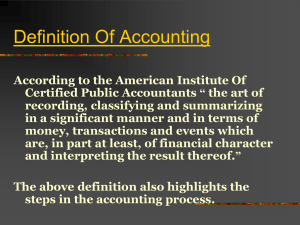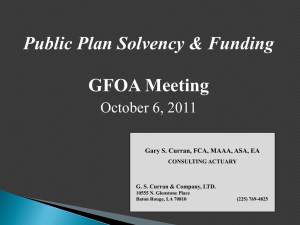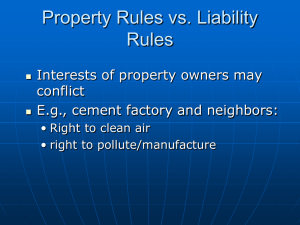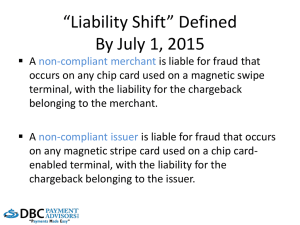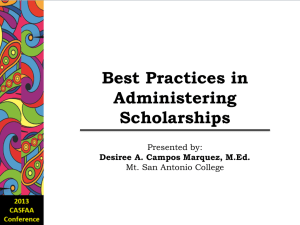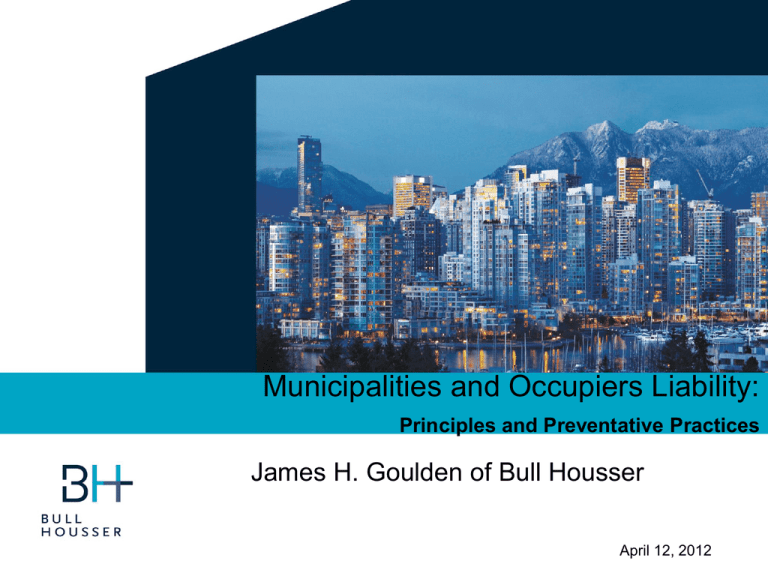
Municipalities and Occupiers Liability:
Principles and Preventative Practices
James H. Goulden of Bull Housser
April 12, 2012
Occupiers Liability - Principles
• Statutory duty of care for persons in
control of property
• Must take reasonable steps to prevent
damage to persons or their property
• Duty is to ensure premises is “reasonably
safe” for those using it
2
General Principles
• Public law principles of negligence apply to
occupiers liability claims against municipalities
• Limited immunity for pure “policy” decisions
• “Operational” decisions may attract liability
• Documentation of policy execution critical
3
Who is an “Occupier”?
• Section 1: any person who has
responsibility for, and control over:
(i) the condition of the premises;
(ii) the activities conducted on the premises;
and
(iii) the persons allowed to enter those
premises
• May be more than one occupier
4
What are “Premises”?
• Defined in s. 1 of the Act to include lands
and structures, including portable
structures such as trailers used for
residence, business or shelter
• Applies to not only structures on land, but
to water and movable structures including
ships, trains and streetcars
5
When does the Duty Apply?
• Duty concerns both safety of the visitor
and any property brought onto premises
• Applies to “activities” conducted on
premises that result in injury, damage
6
Damage caused by Chattels
• Case law inconsistent on damage caused
by chattels or moveable property:
• No statutory duty in case of collapsed chair in
bingo hall
• No duty when plaintiff fell from ladder when
repairing friend’s roof
• But duty held to apply when Wal-Mart
employee fell from a ladder
7
Actions of Third Parties
• Occupier liable for actions of third parties
lawfully present on premises
• Liability established if occupier knew or
ought to have known third party posed
danger
• Example: Jacobson v. Kinsmen Club,
1976 BCJ No. 343, plaintiff injured by
drunken patron climbing on cross beams
at beer garden
8
Scope of Liability
• Standard of care is reasonableness, not
perfection
• Occupier is not an insurer
• No presumption of liability when an
accident happens
• Section 3: occupier must take reasonable
care to ensure that those using the
premises are reasonably safe
9
Duddle v. Vernon, 2004 BCCA 390
• Plaintiff was rendered a quadriplegic when
he dove into shallow water from the City’s
pier at Kalamalka Lake
• City had placed numerous signs
prohibiting diving and warning of the
shallow water
• Plaintiff had used the pier and swam in the
area numerous times in the past
10
Duddle v. Vernon...
• Plaintiff argued that there were further steps the
City could have taken – e.g. signs could indicate
actual water depth, guardrails could be installed
• Court found that City was not required “to do all
they could have done” to prevent the accident
• City had taken reasonable care
• In addition, City could not be held liable for
failing to warn the Plaintiff of dangers of which
he was already aware
11
Prior History of Premises
• Previous safe usage or a history of
accidents is relevant to standard of care
• Damages must be reasonably foreseeable
for liability
• No liability for unforeseeable incidents
12
Prior History of Premises
• Vital to have documentation
• Eg. In Geraghty v. Port Coquitlam (City), 2005
BCJ No. 495, Plaintiff was injured in municipal
swimming pool
• Two lifeguards testified they had never
witness a collision before
• Court gave little weight to this evidence
because the City had not maintained any
records of accidents, safety violations, etc.
13
Prior History of Premises
• Liability may still be imposed if occupier
has untarnished safety record
• E.g. Bilawchuk v. Prince George, 1998 BCJ
No. 2934, hockey player injured wrist on
boards
• Court determined that the fact that a similar
accident had not occurred was “a reflection
of chance, not good management”
14
History of Past Incidents
• Past incidents do not mean occupier is presently
liable
• Eg. Redman v. Saanich, 2004 BCJ No. 2196 –
Plaintiff was injured when exercise ball he was using
burst
• Balls had burst or malfunctioned on three prior
occasions at other facilities and Saanich facility was
likely aware
• Court still found the standard of care was met:
inspection policy followed, balls properly stored, etc.
15
Inspection, Maintenance Policies
• Decisions by government bodies
constrained by many factors
• Policy decisions reflect budgetary
considerations involving allocation of
resources
• Local governments generally not
liable where it follows such policies
• Unless the policy is unreasonable in light of
all the circumstances
16
Inspection, Maintenance Policies
• Municipalities must prove their policy was
carried out
• E.g. Ross v. Vernon, 2009 BCSC 1378
• Plaintiff slipped, fell and was injured on
walkway in municipal park
• City employed contractor to take care of
maintenance
17
Ross v. Vernon...
• Walkway encircled a pond inhabited by wild
ducks and geese
• Plaintiff slipped on bird droppings
• No liability
• Inspection and maintenance policies were
reasonable
• Court found the person responsible for
maintenance was credible and believed his
testimony that he had washed the walkway
earlier that day
18
Willing Assumption of Risk,
Contributory Negligence
• Section 3(3): Where risks willingly
assumed, lower standard applies
• Occupier must not:
• Create a danger with an intent to harm
• Act with reckless disregard to the safety of
others
• Damages may be reduced due by
contributory negligence by plaintiff
19
Willing Assumption of Risk,
Contributory Negligence
• Amerato v. Nanaimo (City), 2006 BCSC 1771
• Plaintiff suffered injury while roller-skating in
municipal arena
• Fell when roller skate came into contact with
Skittles candy that had been dropped
• Evidence was that Plaintiff was aware there
were Skittles on the ground
• Court found Plaintiff was negligent in exposing
herself to danger
20
Warning Signs
• Important to have signage marking any hazards
• E.g. In Duddle v. Vernon, the City had posted
signs prohibiting diving and warning of shallow
water
• The Plaintiff argued that the City should have
posted signs indicating the actual depth
• Court decided City’s signs were reasonable
21
Lovely v. Kamloops, 2009 BCSC
1359
• In Lovely v. Kamloops, plaintiff fell 8 feet from a
transfer station platform while putting refuse in
bin
• The municipality had posted warning signs, but
they were not posted on the transfer station
platforms
• Signs did not warn customers that there was a
risk they could fall from platform to ground below
• Liability apportioned 55% to City; 35% to
designers of transfer station; and 10% to plaintiff
22
Municipal Roads
• Section 8 of the Act exempts municipalities
from statutory duty of care for public roads
• Municipalities may still be liable in
negligence
• Court will examine whether policy
reasonable in the circumstances
• including budgetary considerations
23
Aberdeen v. Township of Langley et al.,
2008 BCCA 420
• Plaintiff was seriously injured while cycling on
a municipal road
• Road was a designated bicycle route
• The Plaintiff was forced onto the shoulder by
an oncoming vehicle, struck a guardrail and
was propelled through a gap and down an
embankment
• Court found City owed a duty of care that the
roadways were reasonably safe for the
purposes of travel
24
Aberdeen v. Township of Langley
• In this case, Langley could not rely on line
of cases limiting municipality’s liability
when there were reasonable inspection
and maintenance policies in place
• Those cases deal with hazards created by
others, or by weather, or by wear and tear
• In this case, the municipality had created
the hazard (the gap)
25
Sidewalks
• The Occupiers Liability Act applies to sidewalks
• Courts will still consider whether there was a
reasonable policy in place that was followed
• E.g. Beadle v. Nanaimo 2009 BCSC 1506 plaintiff tripped over uneven pavement
• City had policy of sidewalk inspection in place
• Court concluded policy was result of “manpower
constraints”, liability not imposed
26
Sidewalks
• Local governments must promptly respond
to known problem areas: Garcha v. New
Westminster, 2005 BCJ No. 1922
• Slip and fall incident occurred on a street
that was 4th highest priority for ice removal
• However, City knew of drainage issues in
the area, melted ice there before
• City liable
27
Sidewalks
• In Knodell v. New Westminster, 2005 BCJ
No. 2026, the same municipality escaped
liability for a slip and fall
• Ice formed on sidewalk due to water from
overhead Skytrain guideway
• No evidence that the City knew about the ice
or that it was a problem area
• City therefore not liable
28
Recreational Trails
• Section 3 of the Act provides a lower
standard of care for recreational trails
• Trail users accept certain inherent risks
• Liability will only be imposed if the
occupier:
• (ii) creates a danger with an intent to harm; or
• (ii) acts with reckless disregard for others’
safety
29
Recreational Trails
• Occupiers of recreational trials are
responsible to conduct repairs and take
reasonable care
• But lower standard means occupier must
only act if failure to do so will likely result
in harm
• Appropriate warning signage should be
posted as necessary
30
Ferris v. Greater Vancouver,
2002 BCSC 215
• Plaintiff fell and was injured while rollerblading in
Seymour Demonstration Forest
• Would have required a “standard of perfection”
to expect road would be completely free of
gravel and small rocks
• No hidden or unusual dangers
• Warning signs posted
• No liability either in negligence or under
Occupier’s Liability Act
31
Exclusion of Liability
• Section 4 of the Act codifies the common
law right of owners or occupiers of
property to “contract out” of liabilities
• Indemnities, exclusion clauses and/or
waivers should be included in local
governments’ contracts with third parties
over civic property
32
Exclusion of Liability
• Special care must be taken to draw the
other party’s attention to such clauses
• To rely on an indemnity or hold-harmless
clause, defendant’s negligence cannot be
proximate cause of damage
• Licensing and lease agreements should
give tenant responsibility / control over
premises
33
Overview of Precautionary Practices
• 1) Establish policies for inspection /
maintenance with specific criteria
• 2) Conduct inspections in systematic way
• 3) Policies should reflect budgetary,
economic and other considerations
• e.g. availability of equipment / personnel
• 4) Employees should follow policies
closely
34
Overview of Precautionary Practices
• 5) Accidents and safety concerns should
be recorded, along with action taken in
response
• 6) Organized records on the execution of
all policies should be kept
• all inspections, repairs and related activities
• 7) Where City learns of a specific danger,
respond promptly
35
Overview of Precautionary Practices
• 8) Post well-positioned and clear signs
warning of hazards
• and associated prohibitions, regulations, etc.
• 9) In contracts, other parties should
assume control over property where
possible
• 10) Include indemnities, releases and/or
waivers in municipal property contracts
36
Conclusion
• The broad scope of liability for
municipalities poses significant challenges
• To minimize liabilities, municipalities must:
• Understand statutory and common law duties;
and
• Implement proactive practices aimed at
reducing exposure to risk
37
ISSUES IN FINANCE
Presented By: Kathleen Higgins
April 12, 2012
OVERVIEW
(1) Borrowing & liabilities
(2) Limits on providing assistance to
business
(3) Publication of intention to provide
certain kinds of assistance to a
person or organization
(1) BORROWING &
LIABILITIES
INTRODUCTION
• Municipalities are subject to significant limitations as
regards their authority to borrow and incur liabilities
• These limitations are set out in:
• The Community Charter (the “Charter”);
• The Municipal Liabilities Regulation (the “MLR”); and
• The Approval of the Electors Exemption Regulation
• Regional districts are also subject to limitations as
regards their authority to borrow and incur liabilities
LIMIT ON BORROWING AND
OTHER LIABILITIES
• A municipality may only incur liability as
expressly authorized under the Charter or
another Act
• A municipality may not incur a liability if incurring
the liability would cause the limit to exceed a
limit established by regulation unless it is
approved by the Inspector of Municipalities
LIABILITIES
LIABILITIES UNDER AGREEMENTS
•
A municipality or regional district may incur a
liability under an agreement if:
•
The liability is not a debenture debt; and
•
The period of the liability is not longer than
the reasonable life expectancy of the
activity, work or service under the
agreement
LIABILITIES UNDER AGREEMENTS
• If an agreement is for more than 5 years or for a
period that could exceed 5 years by exercising
rights of renewal or extension, the municipality
or regional district may only incur liability with the
approval of the electors
• The matter put before the electors must identify:
• The parties to the agreement;
• The nature of the liability;
• The term of the liability; and
• The amount of the liability
LIABILITIES UNDER AGREEMENTS
• Approval of the electors is not required if one of
the following is true:
1.The liability is incurred under an employment
contract or collective agreement;
2.The liability is incurred for the supply of
materials, equipment or services under an
agreement referred to in s.3 of the Police Act;
LIABILITIES UNDER AGREEMENTS
3. If the concept for the partnering agreement
which contains the liability has been approved
by the electors within the 5 year period prior to
the date of the agreement and the agreement is
in accordance with that concept
• Under s. 175(6), the identity of the partner need
not be known or disclosed as part of the
partnering concept, only the nature of the
activity, work or facility, the maximum term, the
maximum liability incurred under the agreement
and any other information required by
regulation
LIABILITIES UNDER AGREEMENTS
4. The liability forms part of a long-term agreement
under which a municipality or regional district
acquires an interest or right in or with respect to
land and the liability is:
a) an obligation that the municipality or regional
district maintain the land; and/or
b) an obligation that the municipality or regional
district indemnify the grantor of the interest or
right being acquired by the municipality or
LIABILITIES UNDER AGREEMENTS
5. The liability is not of a “capital nature” (whether
or not it is or includes a contingent
commitment);
6. The liability is not a loan guarantee given by a
municipality;
7. At the time the municipality proposes to incur
the liability:
a) the annual cost of servicing the aggregate liabilities
of the municipality for the year does not exceed 5%
of the annual calculation revenue of the municipality
for the previous year; and
LIABILITIES UNDER AGREEMENTS
8. The liability is to be incurred for the purpose of
complying with an order of a drinking water officer under
the Drinking Water Protection Act that expressly
requires the municipality to install treatment works and
the inspector of municipalities approves the proposed
liability;
9. The liability is to be incurred for the purpose of:
a) preparing or revising, under the direction of the minister under
section 24(3)(a) of the Environmental Management Act, a waste
management plan respecting the management of municipal
liquid waste; or
a) implementing all or part of, or an amendment to, a waste
LIABILITIES IMPOSED UNDER
PRESCRIBED ENACTMENTS
• S.176 of the Charter authorizes the Cabinet to
make regulations prescribing classes of liabilities
imposed under enactments as liabilities that
municipalities may incur
• No regulations have been enacted in relation to
this type of authorized liability
BORROWING
GENERAL CEILING ON
AGGREGATE LIABILITIES
• The Province can establish basic municipal debt
limits by regulation in two different ways while
retaining the authority of the Inspector of
Municipalities to permit a particular municipality
to exceed the generally applicable level for a
specific purpose
• The Cabinet can prescribe limits on:
• The aggregate liabilities of municipalities; and
• The annual cost of servicing those liabilities
CEILING ON DEBT SERVICING COSTS
• Each current and future expenditure on servicing
municipal debt must be anticipated in the
applicable year of the municipality’s financial
plan
• The MLR prohibits the incurring of new liabilities
if the annual cost of servicing the municipality’s
liabilities exceeds 25 percent of its annual
revenues in certain prescribed categories, or
incurring the new liability would cause the
annual cost to exceed that level
SERVICING LIMIT CERTIFICATE
• The municipality’s financial officer is required to
prepare a liability servicing limit certificate and
submit it with any loan authorization bylaw
tendered for the Inspector of Municipalities
approval and when submitting a leasing
proposal to the Municipal Financial Authority (the
“MFA”)
• The MFA relies on these certificates when it
provides a solicitor’s opinion to lenders in
connection with the issuance of securities for its
borrowing on capital markets
REVENUE ANTICIPATION BORROWING
• Local governments can borrow funds on a shortterm basis to meet current financial obligations
and, in the case of municipalities, their
obligations to other taxing authorities for which
they collect taxes
• Such borrowing may be required to
supplement the local government’s cash flow
during the period before local taxes are due
• The amount that may be borrowed in
anticipation of the current year tax revenue must
REVENUE ANTICIPATION BORROWING
• If the borrowing is undertaken prior to the
adoption of the annual property tax bylaw, the
current year’s unpaid taxes are deemed to be
75% of the total taxes imposed in the preceding
year
• When collected, the revenue from property taxes
must be used as necessary to repay money
borrowed
SHORT-TERM CAPITAL BORROWING
• A council can, by bylaw adopted with the
approval of the Inspector of Municipalities,
contract a debt for any purpose of a capital
nature
• The debt cannot cause the municipality to
exceed the limit prescribed by regulation
• The debt and securities must be payable no
later than the less of:
• 5 years from the date on which the securities were
issued; and
• The reasonable life expectancy of the capital asset for
which the debt is contracted
LOAN AUTHORIZATION BYLAWS :
LONG-TERM BORROWING
• Long-term borrowing occurs through loan
authorization bylaws adopted with the approval
of the Inspector of Municipalities
• A loan authorization bylaw must be its own
bylaw and cannot be included as part of a
general bylaw
• Any refusal of the Inspector of Municipalities to
approve such a bylaw may be appealed to the
Minister of Community Development under
LOAN AUTHORIZATION BYLAWS :
REQUIREMENTS (CONTENT)
• A loan authorization bylaw must set out the
following:
• The total amount proposed to be borrowed
under the bylaw;
• Each of the purposes for which the debt is to
be incurred (generally);
• The amount allocated by the bylaw to each of
the purposes for which the debt is to be
incurred; and
• The maximum term for which the debentures
may be issued
LOAN AUTHORIZATION BYLAWS :
REQUIREMENTS (ELECTOR APPROVAL)
• Generally, loan authorization bylaws must be
approved by electors
• However, approval of the electors is not required
when the money borrowed under the bylaw is
for:
• Court, arbitration and expropriation
requirements;
• Works required to be carried out under an
order of the Inspector of Dikes or and order
LOAN AUTHORIZATION BYLAWS :
REQUIREMENTS (INVOLVEMENT OF
REGIONAL DISTRICT)
• Generally, other than temporary borrowing
permitted by section 181 of the CC, a
municipality can only borrow money under a
loan authorization bylaw if the financing is
undertaken by the applicable regional district
under s.824 of the LGA through the MFA and the
regional district board has consented to
undertake the financing
LOAN AUTHORIZATION BYLAWS :
ALLOWABLE PURPOSES
• Under authority of a loan authorization bylaw, a
municipality can incur a liability by borrowing for
one or more of the following:
1.Any purpose of a capital nature;
2.Lending to any person or public authority
under an agreement;
3.Guaranteeing repayment of the borrowing, or
providing security for the borrowing of a
LOAN AUTHORIZATION BYLAWS :
ALLOWABLE PURPOSES
4. Complying with an order or requirement to pay
money into the Supreme Court as security for:
• Payment of a judgment or other debt;
• Damages or costs; or
• Costs of an appeal from the decision of a
court or an arbitrator
5. Satisfying a judgment or other order of a court
against the municipality;
6. Satisfying an award resulting from an
arbitrator’s determination of liability of quantum
LOAN AUTHORIZATION BYLAWS :
ADDITIONAL POINTS
• The time at which the authority to borrow under
a loan authorization bylaw ends depends on the
purpose of incurring the liability under the bylaw
• The maximum term of a debt that may be
authorized by a loan authorization bylaw varies
depending on the purpose of incurring the
liability under the bylaw
• Temporary borrowing under a loan authorization
bylaw is allowed (pending advance of loan
(2) LIMITS ON PROVIDING
ASSISTANCE TO BUSINESS
GENERAL PROHIBITION
• Generally, local government legislation prohibits
the provision of any form of financial assistance
to businesses including any grant, benefit,
advantage or other form of assistance to a
business
• Specific examples of prohibited financial
assistance include:
• Disposing of land or improvements, or any
interest or right in or with respect to them for
less than market value;
GENERAL PROHIBITION
• The question of whether a particular business
arrangement effects the provision of “assistance”
is one that must be addressed in the isolated
aspect of the arrangement (International Paper
Industries Ltd. V. GVRD)
• For example, allowing private development of
municipal property in a large-scale civic centre
project is not, per se, providing assistance to the
developer (Dales Properties Ltd. v. Surrey (City))
EXCEPTIONS
• The provision of assistance to business is
expressly authorized in five
circumstances
EXCEPTION # 1:
PARTNERING AGREEMENTS FOR THE
PROVISION OF A SERVICE ON ITS BEHALF
•
The provision of assistance to business is expressly
authorized where the local government enters into a
partnering agreement for the provision of a service on
its behalf
•
“Partnering agreement” is defined in the Schedule to the
Charter and s.5 of the LGA as an agreement between a local
government and a person or public authority under which the
person or public authority agrees to provide a service on behalf
of the local government other than a service that is part of the
general administration of the local government
•
“Service” is defined in in the Schedule to the Charter and s.5 of
the LGA an activity, work or facility undertaken or provided by or
on behalf of a municipality or regional district
EXCEPTION # 1:
PARTNERING AGREEMENTS FOR THE
PROVISION OF A SERVICE ON ITS BEHALF
• Since a BC local government can provide any
service that the council or regional board
considers necessary or desirable, this criterion
would appear to be easy to satisfy
• It is critical that the agreement actually identify
the municipal service that is being provided
• The purpose of the partnering agreement
exception is so that when a local government is
negotiating a partnering agreement it can bring
EXCEPTION #2: HERITAGE RESOURCES
• The provision of assistance to business is
expressly authorized where the assistance has
to do with:
• Acquiring, conserving and developing heritage
property and other heritage resources;
• Gaining knowledge and increasing public awareness
about the community’s history and heritage;
• Any other activities the municipality or regional district
considers necessary or desirable with respect to the
EXCEPTION #3: TAX EXEMPTION
• The provision of assistance to business is
expressly authorized where the assistance is in
the form of a tax exemption provided under
s.225 or s.226 of the Charter or s.812 of the
LGA
EXCEPTION # 4: CAPITAL FINANCING
• The provision of assistance to business is
expressly authorized where a regional district is
providing capital financing for a natural gas,
telephone or electric power utility
EXCEPTION # 5: BUSINESS
PROMOTION SCHEME
• The provision of assistance to business is
expressly authorized where the assistance is a
business promotion scheme undertaken in a
business improvement area
(3) PUBLICATION OF
INTENTION TO PROVIDE
CERTAIN KINDS OF
ASSITANCE TO A PERSON
OR ORGANIZATION
PUBLICATION OF INTENTION TO PROVIDE
CERTAIN KINDS OF ASSISTANCE
• If council intends to provide certain kinds of
assistance to a person or organization it must
give public notice of this intention
• The kinds of assistance which require public
notice include:
• Disposing of land or improvement, or any
interest or right in or with respect to them, for
less than market value;
• Lending $$$;
• Guaranteeing repayment of borrowing or
providing security for borrowing;
FORM & CONTENT OF NOTICE
• The notice must:
• Be given in accordance with s.94 of the
Charter (it must be posted in public notice
posting places and published in a newspaper
with at least weekly distribution in the area
affected for two consecutive weeks)
• Be published before the assistance is
provided;
• Identify the intended recipient of the
assistance; and
• Describe the nature, term and extent of the
Seven Habits of Frequently Sued Managers
Presented by Ryan Berger
April 12, 2012
Habit One
Hire Quickly, Not Carefully
A Critical Decision – Treat it That Way
• Most employment claims can be traced to poor
hiring decisions
• Don’t rush the process
• Trust your instincts
• Prepare for interviews
• Explore gaps in the resume
Some Interviewing Do’s & Don’ts
• Do get job-related
background information
• Do ensure the candidate
can perform “essential job
functions”
• Do understand what
makes the candidate
unique
• Do document reasons for
selection/rejection
• Don’t let age, gender,
marital status creep in
• Don’t ask about
disabilities or limitations
• Don’t probe personal or
lifestyle issues
Common Mistakes
• What does your husband do?
• How many kids do you have?
• Are you planning to have more kids?
• Have you ever filed a workers’ compensation
claim?
• What country are you from?
Avoiding “Hiring Fraud”
• Be straight, don’t puff or exaggerate
• Rely on written materials whenever possible
• If you don’t know, say so
• Defer to HR on details about the hiring process
• Be especially careful when “luring” someone
from other employment or someone moving
here to take the job
Habit Two
Avoid Documenting Termination Provisions
Common Mistakes
• No termination provisions in contract
• Independent contractors that are really
employees
• Automatic bonuses
• Allowances for car, cell phone
• Failure to give clear notice of termination
Limit Exposure Related to Dismissal
• If it is a duck, don’t try to call it an
independent contractor
• Make bonuses discretionary
• Give reimbursements, not allowances
• Clear termination clause (compliant with
Employment Standards)
• Give clear notice
Habit Three
Don’t Document – Just Rely on Memory
Why Document?
• Plaintiffs do, so you are at a disadvantage if you
don’t
• Your memory isn’t what it used to be
• The average judge won’t believe it if it isn’t
documented
• Because employers have the burden of proof to
justify discipline, they must keep thorough
records
• Even if not proceeding with discipline, document
everything
How to Document
1. Do whatever works – to be able to recall
details a year or more later
2. Use the company’s forms when possible
3. Do it contemporaneously (or darn close)
4. Don’t overdo it
5. Keep it
Key Areas to Document
• Performance – conduct that could lead to disciplinary
action
• Misconduct, harassment investigations
• Accommodation conversations – notes of meetings
• Leave and return to work issues
• Basis for decisions on disciplinary action
• Keep signed copies of all letters
Habit Four
Avoid Confrontation or Criticism
During Performance Management and
Reviews
Performance Reviews
• Issues of performance are almost always central
to a discrimination or termination claim
• Don’t “sugar coat” the review; it will come back
to haunt you
• Remember – courts and arbitrators hold
organizations to what they say in the reviews
Effective Performance Management
• Communicate goals and expectations clearly
• Don’t wait for formal “reviews”
• Be fair, honest, and consistent
• Fair criticism takes time and thought
>
Praise the good and criticize the bad
>
Don’t just criticize – provide the tools and the time to foster
improvement
Documentation
• Contemporaneously document
misconduct, performance problems and
counselling sessions
• Remember: “if it isn’t documented, it didn’t
happen”
Common Problems
• Ignoring the problem until it becomes a
major issue, and then expecting to
terminate for cause or fix it immediately
• The desire to transfer a bad employee to
another department, instead of dealing
with it
• “Bottom drawer” files
Performance Management
• Discipline is not always the answer or the
first step
• Performance management often becomes
the foundation for discipline
• Part of setting an employee’s expectation
• Correct past bad behaviour and improve
performance
• Should be in writing and should state that
it is not discipline
Performance Management
• Go through improvement plan with the
employee in person
• Set clear, achievable goals
• Provide ongoing support to the employee
• Consider appropriate external support
Marriage breakdown?
> Child with drug addiction?
>
Performance Management
• Tailor a plan to each employee
• Get input from the employee when
creating
• Have employee sign the plan
• Follow up on the plan and monitor
performance
• Provide constructive criticism
• Reward improvement (positive
reinforcement)
The Disciplinary Process
• Discipline must be individualized– there is no
cookie cutter approach to disciplining employees
• An employer is expected to consider all of the
relevant circumstances before imposing
discipline
• An investigation helps to identify all of the
relevant factors (investigations are discussed
later)
Steps in Progressive Discipline
• Verbal warning –
not worth the paper
it's not written on
• Letters of expectation
- not disciplinary
• These are part of
management of
employees, but are
not discipline
Steps in Progressive Discipline
•
•
•
•
Warning letter
Short suspension
Long suspension
Termination
Habit Five
Tolerate Crude, Lewd and Offensive
Behaviour
Top 5 Reasons Why You Should be
Concerned About Harassment
1. Harassment is disrespectful, degrading and
demoralizing
2. Employees perform better in a harassmentfree work environment
3. It’s not just the employer’s pocketbook; it could
be yours as well
4. It’s the law
5. It’s policy
Hostile Environment
• Jokes, remarks
• Pictures, downloads, screensavers
• Looks and gestures
• Touching, blocking way
“e-Harassment?”
• E-mail is ubiquitous
• E-mail is a powerful distribution tool
• E-mail is forever
Where is the “Workplace?”
• Lunches / Dinners
• Business trips
• “Official” Parties / Gatherings
Who Can Harass?
• Supervisors
• Co-Workers
• Customers
• Contractors
Tried and True Defenses
(That Failed)
• “It’s nothing you wouldn’t hear on TV.”
• “I’m just a ‘touchy-feely’ type.”
• “I didn’t mean anything by it.”
• “She never told me to stop.”
• “It had nothing to do with sex.”
Avoiding Harassment Claims
• Set an example
• Intervene early – be proactive
• Don’t punish the messenger
• Conduct thorough, good faith investigations
• Impose / support decisive corrective action
Habit Six
Give Short Shrift to Requests for Leave or
Accommodation
An Employee has the
Right to Miss Work…
• For their own sickness
• To care for a sick child, parent, spouse
• For bereavement leave
• To vote
• To attend rehab
• Intermittently or on a reduced schedule to treat
or recover from a serious health condition
• For pregnancy and parental leave
Human Rights Code
• A person must not
(a) refuse to employ or refuse to continue to
employ a person, or
(b) discriminate against a person regarding
employment or any term or condition of
employment
because of a number of protected grounds
Protected Grounds
• race, colour, ancestry, place of origin, political
belief, religion, marital status, family status,
physical or mental disability, sex, sexual
orientation or age of that person or because that
person has been convicted of a criminal or
summary conviction offence that is unrelated to
the employment or to the intended employment
of that person
Bona Fide Occupational
Requirement (BFOR)
• Prohibitions do not apply with respect to a refusal,
limitation, specification or preference based on a “bona
fide occupational requirement”
• A BFOR will exist where the policy, rule, or requirement:
• was adopted for a purpose rationally connected to the
performance of the job
• was adopted in an honest and good faith belief that it
was necessary to the fulfillment of that legitimate
work-related purpose; and
• where the policy, rule, or requirement is reasonably
necessary to the accomplishment of that legitimate
work-related purpose
Nature and Extent of Accommodation
• Undue hardship does not mean impossible
to accommodate
• The duty to accommodate does not alter
the fundamental contract of employment:
the performance of work for remuneration
• Several factors are considered when
determining whether undue hardship
exists (e.g. cost; workplace morale, etc.)
What is a disability?
• Disability is not a defined term in the
Human Rights Code
• Includes perceived disability
• Examples:
•Bi-polar disorder
•Depression
•PTSD
•Panic disorder
•Schizoaffective disorder
•Dyslexia
•Alcohol /drug addiction
•Severe learning disorder
•Anxiety
Assessing the Disability
• Onus is usually on the employee to
communicate the nature of the disability to
the employer
• BUT it is not necessary for an employee to
notify the employer of the nature of his or
her disability for a complaint of
discrimination to succeed; this is
particularly true with mental disabilities
What information can /
should you get?
• Duty to inquire
• Ask for:
• nature of the illness or disability (i.e. recurring or
chronic)
• prognosis for full or partial recovery, expected
duration of absence / date of return
• the employee’s functional capabilities
• what accommodations are necessary at work
• whether treatment prescribed and followed
• evidence that the employee is fit to return to work
Assessing Disability
• Do not ask for:
•
•
•
•
the employee’s diagnosis
the kind of treatment
IME
direct contact with the employee’s doctor and
the doctor’s records
(there are exceptions)
Habit Seven
Failure to Investigate Allegation
(or properly investigate)
Managers will sometimes…
• Take action on the word of a single
employee
• Not act to investigate when the information
is fresh
• Fail to consider the evidence objectively
• Fail to provide the employee with an
opportunity to respond
Investigations
• Mere suspicion or allegation of wrongdoing is
not enough to take action
• Investigate any conduct immediately when you
learn of the conduct and the conduct may be
worthy of some kind of action, disciplinary or
otherwise
• The mere potential for action is sufficient to
trigger an investigation— an investigation is
what helps you to determine whether any action
is needed
When do you conduct investigations?
• Immediacy is important because:
• Memories fade over time
• Arbitrators and Courts will downgrade the
severity of the conduct to the employer if the
investigation is delayed– a delayed
investigation suggests that the conduct is not
that severe
How to conduct an investigation
• Basic Rule: Take a thoughtful and rational
approach
• Is an investigation needed to fully understand what is
going on?
• How does the conduct relate to the employee’s job?
• What was the fallout?
• What do your policies say?
• Who is involved?
Why conduct an investigation?
• Examples of conduct that has warranted
investigation:
•
Absenteeism
•
Harassment
•
Expense claims
•
Mileage claims
•
Off-duty conduct (e.g. internet postings; charges)
Some Key Components
•
•
•
•
•
•
Who should investigate?
Are there applicable policies?
Documentation
Provide an opportunity to be heard
(Shop Steward right?)
Closure
• Questions?
Seven Habits of Frequently Sued Managers
CONTAMINATED SITES ISSUES FOR LOCAL
GOVERNMENTS
Presented by Olga Rivkin
April 12, 2012
Presentation road map
• Site profiles and site investigations
• Development freeze (sections 946.1 and
946.2 of LGA)
• Remediating contaminated sites
• Sale/Purchase of contaminated sites
• Municipal roads and other issues
Legislative scheme
• Key legislation:
• Environmental Management Act
• Contaminated Sites Regulations
• Protocols and guidelines under the EMA
• Purpose: “the prevention of pollution and
the identification and remediation of
contaminated sites”
• (Beezer East, Inc. v. British Columbia
(Environmental Appeal Board))
What is a contaminated site?
• “Contaminated site” means an area of
land in which the soil or any groundwater
lying beneath it, or the water or the
underlying sediment, contains
• (a)
a hazardous waste, or
• (b)
another prescribed substance
in quantities or concentrations exceeding
prescribed risk based numerical criteria or
standards or conditions
• The site profiles and the site investigations
Identifying contaminated sites
• Site profile is submitted (to municipality,
approving officer, director, or otherwise).
• In some circumstances, site profiles are
forwarded to the director.
• Preliminary/Detailed site investigation (decision
about the investigation to be made within 15
days of director receiving a site profile).
• Development freeze (if application for
subdivision/zoning/soil
removal/DP/DVP/demolition).
Identifying contaminated sites – cont.
• A person must provide a site profile:
To the approving officer upon subdivision of land
used for industrial or commercial activity;
> To the municipality upon:
>
>
>
>
>
>
Zoning,
DP/DVP,
Soil removal,
Demolition permit, or
A prescribed activity
Identifying contaminated sites – cont.
• An owner of real property must provide a
site profile:
>
To the director (under the EMA) if the owner:
>
>
>
>
Owns real property that is used or has been used for
specified activities;
Dismantles a building or structure, or decommissions a
specified site;
Applies for an approval of a specified activity; or
Undertakes activities or receives information prescribed
by regulations.
Identifying contaminated sites – cont.
• A vendor of real property who knows or
should know that real property has been
used for a prescribed purpose or activity
must provide a site profile to a prospective
purchaser.
• A director may order a person to prepare
and provide a site profile if the director
suspects the person owns or occupies a
contaminated site.
Identifying contaminated sites – cont.
• Exemptions from providing site profiles
• Section 4 of the CSR lists exemptions to
providing a site profile. Some examples:
Municipality undertakes to rezone land in which it
has no interest
> Municipality undertakes to rezone land the
municipality does not intend to develop and
municipality commits to submit a site profile upon
development
> A purchaser waives, in writing, a right to receive a
site profile
>
Identifying contaminated sites – cont.
• Upon receipt of a site profile, approving
authorities (such as municipalities) have a duty
to assess and ensure the site profile is properly
prepared.
• If any question in sections IV through IX of the
site profile is answered “yes”, the approving
authority or the individual is required to forward
the site profile to the director.
• Site profiles without “yes” get sent to the Site
Registrar to be registered in the Site Registry.
Identifying contaminated sites – cont.
• Site Investigations
• Preliminary site investigation
>
Searching existing records about site use, interviewing
people (section 58, CSR)
• Detailed site investigation
>
More detailed work than PSI to determine location, extent
and impact of contamination (section 59, CSR)
• Director may order a PSI or a DSI to be conducted
upon receipt of the site profile.
• Director must notify the municipality and the person
(who provided a site profile) within 15 days of receipt
of a site profile if a PSI or a DSI would be required.
Identifying contaminated sites – cont.
• Site risk classification
• Protocol 12 – came into force on June 1, 2010.
• Procedure for classifying sites and parts of sites
based on their environmental and human health risk.
• Sites which are classified high risk require high
standard of care and responsiveness in investigation
and remediation.
• Triggers for a site risk classification report include
submission of a site investigation, submission of
independent remediation initiation, notification of
offsite migration and more.
• Development freeze – sections 946.1 and
946.2 of the LGA
Development freeze
• In 1990s local governments indicated that they wanted to
be involved in the contaminated sites screening process.
• In 1996, sections 946.1 and 946.2 were added to the
then Municipal Act (equivalent sections were added to
the Vancouver Charter (571B), the Land Title Act (85.1)
and Island Trust Act (34.1)). Currently, sections 946.1
and 946.2 of the LGA.
• Local governments have an option to opt out of the
contaminated sites screening system – will not be
collecting site profiles.
• The land owners and operators will still be subject to
other provisions in the contaminated sites regime.
Development freeze – cont.
• A site profile requirement triggers
“development freeze”.
• Section 946.2 of the LGA provides that a
municipality must not approve an
application for zoning, DP/DVP, soil
removal or demolition until one of the
seven “releases” takes place.
Development freeze – cont.
• Releases:
• Authority is not required to forward a site profile to the director;
• Authority has forwarded the site profile and no further
investigation (PSI/DSI) is required;
• Authority has received a final determination that the site is not a
contaminated site;
• Authority has received a notice that application can be approved
(a release letter);
• Authority has received notice that director has received and
accepted notice of independent remediation;
• Authority has received notice that the Director has entered into
voluntary remediation agreement; and
• Authority has received an AIP or a CC.
Development freeze – cont.
• Immunity in relation to contaminated sites
• Local governments (as well as their current
and former employees and agents and
current and former elected officials) are
immune from liability in relation to any act,
advice, failure to act or failure to make
recommendations in relation to sections 946.1
and 946.2 of the LGA provided that their
conduct is not dishonest or malicious (section
61, EMA).
• Remediation of contaminated sites
Remediation of contaminated sites
• Liability for remediation
• “Responsible persons” is a broad concept.
• Liability extends to current and former owners as well
as persons who produced a substance and caused it
to be deposited.
• Section 45 of the EMA lists persons responsible for
the remediation.
• Case law often revolves around determination of
responsible persons and establishing the
apportionment of liability (see, for example, Gehring v.
Chevron Canada Ltd.; Shoal Point v. ICI, etc.).
Remediation of contaminated sites –
cont.
• Liability for remediation
• Section 46 of the EMA – exemptions from
liability.
• For example, a municipality is not a
responsible person in respect of roads,
provided that the municipality did not cause
the contamination.
Remediation of contaminated sites –
cont.
• Remediation standards
• Director may issue an approval in principle
stating that a remediation plan for a
contaminated site has been reviewed and
approved by the director and may be
implemented in accordance with set
conditions.
Remediation of contaminated sites –
cont.
• Remediation standards
• Director may issue a certificate of compliance
if the site has been remediated in accordance
with:
>
The numerical or risk based standards prescribed
for the purposes of the definition of “contaminated
site”, any orders under the EMA, any remediation
plan approved by the director and any
requirements imposed by the director
Remediation of contaminated sites –
cont.
• Remediation standards
• Application of numeric standards:
Site is considered remediated if it does not contain
any substance with a concentration greater or
equal to the applicable generic numerical
soil/water and vapour standards (numeric soil,
water and vapour standards are set out in
schedules 4, 6 and 11 of the CSR)
> Sometimes, site-specific numeric standards can be
developed (Protocol 2)
>
Remediation of contaminated sites –
cont.
• Remediation standards
• Application of risk-based standards:
>
>
Site considered remediated if for any non-threshold
carcinogenic substance, the calculated human lifetime
cancer risk due to exposure to that substance at the site is
less than or equal to a risk value recommended by the local
medical health officer for the site and for any substance for
which a hazard index is calculated, the hazard index due to
exposure of a human to that substance at the site is less than
maximum hazard index recommended by the local medical
health officer for that site.
Procedures, such as monitoring risk, will be required.
• Sale/purchase of contaminated sites – risk
allocation
Sale/Purchase
• Potential liability for remediation of site as
current and former owner.
• All exceptions from liability of relevance to
sale/purchase of land require that a
responsible person who wishes to benefit
from the exceptions investigate the status
of the property at disposition.
Sale/Purchase – cont.
• Due diligence searches (site registry,
Ministry of Environment, Department of
Fisheries and Oceans, Court Registry)
Sale/Purchase – cont.
• “As is” – the vendor refuses to accept any
post-closing environmental risk.
Transaction contemplates full disclosure of
information by the vendor. Purchaser
relies on their own investigation.
• Usually, accompanied by an indemnity
provision by the purchaser in favor of the
vendor.
Sale/Purchase – cont.
• Closing date allocation
• The closing date is the cut-off of liability, with
the vendor accepting responsibility for before
closing and the purchaser for after.
• Important to have a baseline report
delineating what is before and what is after
Sale/Purchase – cont.
• Conditions of transfer:
• Due diligence
• Remediation to a certain standard:
>
Common to include a certificate of compliance as a
mutual condition (or one of the parties’ condition) –
the transaction does not proceed unless the
condition is satisfied.
• Municipal roads and other issues
Municipal roads
• Since 2004, municipalities own the roads.
• Municipalities can close and dispose of roads.
• Most roads are contaminated due to transportation of
goods, salting, off-site migration, etc.
• Municipalities are not responsible persons in respect of
road contamination (provided they did not place the
contamination there).
• Upon disposition, contamination of roads should be
considered in a sale/purchase agreement – preferably,
dispose on an “as is” basis.
• Also, contamination should be considered when land is
dedicated as roads by developers.
Other issues
• Containment walls – sometimes an
approval in principle of a remediation
includes constructing a containment wall
• Off-site contamination remediation –
agreement to remediate a municipal
streets.
Questions?


